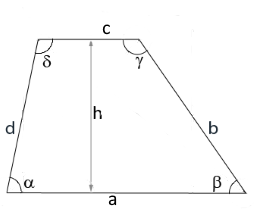Calculate Trapezoid Height using Angle
Calculator and formulas for trigonometric height calculation
Trapezoid Height via Trigonometry
Trigonometric height calculation
The height h is calculated using the sine function from a leg and its angle — either side b or d with corresponding angles.
Trapezoid with Angles

The diagram shows a trapezoid with legs b and d and angles α, β, γ, δ.
The height h is computed trigonometrically using sine.
Trigonometric height calculation
The trigonometric method uses the sine function for direct height calculation:
- Direct calculation: No intermediate steps needed
- Sine function: h = side × sin(angle)
- Multiple options: Different side-angle combinations
- Practically measurable: Angles often easier to measure than areas
- Accurate results: High precision with accurate angles
- Versatile: Works for all trapezoid shapes
Sine function in the trapezoid
The sine function enables direct height calculation:
Basic principle
Projection of the leg onto the height
Right triangle
The height forms a right triangle with the leg and base, making the sine relation applicable.
Practical applications of the angle method
The trigonometric height calculation is beneficial across many fields:
Surveying & Geodesy
- Theodolite angle measurements
- Triangulation in land surveying
- Height determination for inaccessible objects
- GPS-assisted surveying tasks
Construction & Engineering
- Roof pitches and rafter lengths
- Slope angles in earthworks
- Staircase construction
- Bridge and tunnel engineering
Mechanical engineering & Technology
- Wedge angles and inclinations
- Gear geometry
- Tool angles
- Robotics and kinematics
Design & CAD
- Parametric modelling
- 3D modelling
- Technical drawings
- Architectural software
Formulas for trigonometric height calculation
Base formula: sine-based height calculation
General form for all leg-angle combinations
Using leg b and angle β
Right leg with top angle
Using leg b and angle γ
Right leg with bottom angle
Using leg d and angle α
Left leg with top angle
Using leg d and angle δ
Left leg with bottom angle
Alternative: height from area
When area A and parallel sides a, c are known. Available here →
Trigonometric fundamentals
\(\sin(\text{angle}) = \frac{\text{opposite}}{\text{hypotenuse}}\)
In our case: height / leg
\(\text{height} = \text{leg} \cdot \sin(\text{angle})\)
Solved for the height
Degrees (°) or radians (rad)
Conversion: rad = deg × π/180
\(0° \leq \text{angle} \leq 180°\) for trapezoids
sin(angle) is always positive
Calculation Example
Given
Find: height h of the trapezoid
1. Determine sine value
Known trigonometric value
2. Calculate height
Apply the formula
3. Verification with complementary angles
\[h = 4 \cdot \sin(120°) = 4 \cdot \sin(180° - 60°) = 4 \cdot \sin(60°) = 3.464\]
The result is identical because sin(120°) = sin(60°)
The height is approximately 3.46 length units
4. Plausibility check
Logical checks:
• The height (3.46) is smaller than the leg (4.0) ✓
• At 60° expect about 87% of the leg ✓
• sin(60°) ≈ 0.866, so 4 × 0.866 = 3.464 ✓
Practical meaning: With a rafter of 4m and 60° pitch the building height is about 3.46m.
Trigonometric height calculation in theory and practice
The trigonometric calculation of trapezoid height connects classical geometry with practical applicability. While other methods require intermediate calculations, the sine function provides a direct and elegant solution. This method is particularly valuable where angles are precisely measurable or specified as design parameters.
Trigonometric fundamentals
Applying the sine function in the trapezoid is based on fundamental principles:
- Right triangle: The height forms a right triangle with each leg
- Sine definition: sin(α) = opposite/hypotenuse = h/leg
- Solve for h: h = leg × sin(angle)
- Universality: Works with all four angles of the trapezoid
- Accuracy: Direct calculation without rounding errors from intermediates
Angle options and relevance
The four calculation options provide flexibility depending on available data:
Leg b (right)
With angles β (top-right) or γ (bottom-right). Often easier to access in practice.
Leg d (left)
With angles α (top-left) or δ (bottom-left). Alternative when the left side is more accessible.
Complementary angles
Opposite angles are often supplementary (α + γ = 180°, β + δ = 180°), useful for verification.
Measurement strategies
Choose the most accessible angle depending on site conditions and instruments.
Practical measurement and application procedures
Trigonometric height calculation is widely used in practice:
Surveying techniques
- Theodolite measurements for precise angles
- Triangulation in geodesy
- Laser distance meters with angle capability
- GPS-assisted surveying with inclination sensors
Construction
- Roof pitch and rafter length calculations
- Slope angles in earthworks
- Stair rise calculations
- Ramps for accessibility
Mechanical engineering
- Wedge angles in gear systems
- Tool geometry for cutting tools
- Guide rails and sliding paths
- Robot kinematics and joint angles
Design and architecture
- Parametric design in CAD systems
- Facade inclinations and solar shading
- Landscape modeling
- Stage and event engineering
Modern technologies and digital integration
Trigonometric height calculation benefits from modern technologies:
- Smartphone apps: inclinometers and angle apps for quick field measurements
- Drone surveying: automatic angle capture from aerial images
- 3D scanners: precise capture of complex geometries
- CAD integration: parametric models with automatic trigonometry
- IoT sensors: continuous monitoring of inclinations and angles
- Machine learning: pattern recognition in image analysis
- Augmented reality: real-time angle measurement and visualization
Accuracy considerations and error sources
Various factors should be considered in practical application:
Measurement accuracy
Height accuracy depends directly on angle measurement precision. A 1° error can have significant impact.
Trigonometric stability
For very small or very large angles the sine function becomes unstable. Best results for angles between 20° and 160°.
Environmental influences
Temperature, humidity and atmospheric conditions may need consideration for precise measurements.
Calibration
Regular calibration of instruments is essential for reliable results.
Summary
Trigonometric height calculation for trapezoids demonstrates the elegance of mathematical methods in practical applications. The direct sine relation h = leg × sin(angle) turns complex geometric problems into solvable calculations. From classical surveying to modern CAD and IoT, this method shows the enduring relevance of trigonometry in a digital world.
|
|